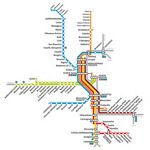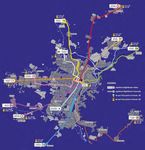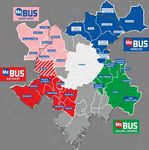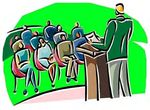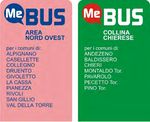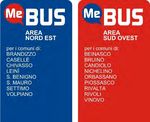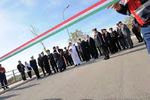ROLE, FUNCTIONS AND STATUS OF TRANSPORT AUTHORITIES - Agenzia della Mobilità Piemontese CASTELLBISBAL 07.06.2017
←
→
Trascrizione del contenuto della pagina
Se il tuo browser non visualizza correttamente la pagina, ti preghiamo di leggere il contenuto della pagina quaggiù
Agenzia della Mobilità Piemontese ROLE, FUNCTIONS AND STATUS OF TRANSPORT AUTHORITIES CASTELLBISBAL 07.06.2017
L’AGENZIA DELLA MOBILITA’ PIEMONTESE
The AGENZIA DELLA MOBILITA’ PIEMONTESE [AMP] is a
public body. It exercises, in the form of consortium, the
functions of local authorities on public transport
There are no other bodies in Italy with the same structure
and legal status.
may 2003 november 2015
AREA METROPOLITANA TORINO REGIONE PIEMONTE
popolazione 4,42 milioni
superficie 25.400 km2
densità 174 ab/km2
in 2003 it has ben established for Torino and its metropolitan In 2015 it was extended to the
area (Agenzia Mobilità Metropolitana di Torino) entire Piedmont region
2L’AGENZIA DELLA MOBILITA’ PIEMONTESE
MISSION
The Agency has the objective to foster the sustainable mobility in Piedmont, optimizing
public transport services by:
• Planning mobility strategies
• Programming the development of public transport's:
‐ infrastructures, vehicles and control technologies
‐ service quantity and quality
‐ resources for the operation and investments
• Managing
‐ fares system
‐ contributions of the associated Local Authorities
‐ contracts with the Transport Companies
‐ communication and information
3L’AGENZIA DELLA MOBILITA’ PIEMONTESE
MAIN FUNCTION
Service Service
Programming Monitoring
Network
Plans and
development
projects
and extension
Tender offers Data and
and contracts Statistics
4L’AGENZIA DELLA MOBILITA’ PIEMONTESE
FUNCTIONS
The new Agency is responsible for the local public transport in the Region and is the
owner of all service contracts previously held by various public bodies (Region,
Province, Metropolitan City, Most Popular Municipalities).
AGENCY MEMBERS
Regione Piemonte Comuni già aderenti Enti soggetti di delega sul TPL
all’Agenzia per la Mobilità PROVINCIA DI ALESSANDRIA
PROVINCIA DI ASTI
Città Metropolitana Torino Metropolitana PROVINCIA DI BIELLA
PROVINCIA DI CUNEO
Comune di Alpignano Comune di Orbassano PROVINCIA DI NOVARA
Comune di Baldissero Torinese Comune di Pecetto Torinese PROVINCIA DI VERBANIA
Comune di Beinasco Comune di Pianezza PROVINCIA DI VERCELLI
Comune di Torino Comune di Borgaro Torinese Comune di Pino Torinese Conurbazione Alba
Comune di Cambiano Comune di Piobesi Torinese Conurbazione Bra
Comune di Candiolo Comune di Piossasco Conurbazione Casale M.to
Comune di Carignano Comune di Rivalta di Torino Conurbazione Cuneo
Comune di Caselle Torinese Comune di Rivoli Conurbazione Ivrea
Comune di Chieri Comune di San Mauro Torinese Conurbazione Vercelli
Comune di Collegno Comune di Santena Courbazione Novara
Comune di Druento Comune di Settimo Torinese Comune di Alessandria
Comune di Grugliasco Comune di Trofarello Comune di Asti
Comune di La Loggia Comune di Venaria Reale Comune di Biella
Comune di Leini Comune di Vinovo Comune di Pinerolo
Comune di Moncalieri Comune di Volpiano Comune di Verbania
Comune di Nichelino
5L’AGENZIA DELLA MOBILITA’ PIEMONTESE
ORGANIZATION
The participation fees of the members of the Consortium are
REGIONE PIEMONTE CITTÀ DI TORINO
25% 25%
BACINO DELLA BACINO NORD
CITTÀ METROPOLITANA [BIELLA, NOVARA, VERCELLI
DI TORINO– 11% VCO] ‐ 15%
BACINO SUD‐OVEST BACINO SUD‐EST
[CUNEO]– 13% [ASTI‐ALESSANDRIA]– 11%
ORGANI DI GOVERNO
ASSEMBLY BOARD
President [Assessore Regionale] 1 President
1 member (mayor) from each 4 Member
represented Body (1 from each Bacino)
6L’AGENZIA DELLA MOBILITA’ PIEMONTESE
FUNCTIONS
From the point of view of contract management and programming of services, the
Agency operates by “Bacino” according to the following structure:
BACINO METROPOLITANO BACINO NORD
[TORINO] [BIELLA, NOVARA, VERCELLI
VERBANO‐CUSIO‐OSSOLA]
BACINO SUD‐OVEST BACINO SUD‐EST
[CUNEO] [ASTI‐ALESSANDRIA]
There are:
COMITATO TECNICO AGENZIA
Director of the Agency + 6 responsible for
transport (one representing Piedmont Region,
one representing the City of Turin and one for
ASSEMBLEE DI BACINO each basin)
They are chaired by the representative of
the “bacino” in the board of directors.
They are formed by a member (Mayor or
President) for each Province and
Municipality
COMISSIONI TECNICHE DI BACINO
Composed of the directors of the individual bodies involved in the basin. The works are
coordinated by the representative of the basin in the Comitato Tecnico Agenzia.
7IL TRASPORTO PUBBLICO
SERVIZI URBANI SERVIZI EXTRA URBANI
AREA
METROPOLITANA METRO TRAM BUS SFM
TORINO BUS
1 line 8 Tram lines 30 lines 8 lines
Bus lines daily departures daily departures
78 Torino 812 (Weekday) 358 (Weekday)
Bus lines
8 Other Municipality
production
Millions of vehicles*km
per year
2.8 44.4 4.2 6.2
passengers
Millions
per year
38.8 153.9 3.8 17.8
REST OF
REGIONE BUS BUS SFR
PIEMONTE
4 RV lines
15 R lines
production
Millions of vehicles*km
per year
9.4 60.5 12.7
passengers
Millions
per year 110,3 33,9
8L’AGENZIA DELLA MOBILITA’ PIEMONTESE
BUS CONTRACTS FOR BACINO
AMM
production
64,85
Millions of bus/tram*km
per year
1
2,3
L LA
B IE
cia
vin
Pro
3,77
RA
OVA
incia N
Prov
AREA
METROP.
83,93 4,30
Provincia VCO
NORD
BACINO NORD 16,56
12,6% Provincia VERC
AREA EL LI 2,96
Comune
METROPOLITANA BIELLA
Comu 0,27
63,8% ne NO
BACINO OVEST OVEST Com VARA
une 2,53
12,0% VER
15,79 C EL
LI 0
,42
SUD Pro
15,30 vin
ci aA
BACINO SUD LE
SS
11,6% A ND
RI
A
7,9
Pr
5
ov
in
8
Co mun e CA
ci
,0
a
Co mun
19
mu e A SA
A
Co
ST
ne
O
I
N
4,
AL
RI
43
4
Provinc
ES 1,21 ,24
TO
Comune ALBA 0,38
A 0,40
EO 2,3
ST
SA
na
I
ND
tali
ia CUN
LE
po
Comune BR
RI
e CU N
ro
A
0
et
1,9
M
7
ttà
EO 12
Comun
Ci
,18
9PROJECTS
SFM | SERVIZIO FERROVIARIO METROPOLITANO
Since December 2012, is active the SFM
[Servizio Ferroviario Metropolitano /
Metropolitan Rail Service], connecting Torino
with the Metropolitan Area. At the center of the
system the new Porta Susa station where takes
place interchange with regional lines and high
speed trains
8 LINES
93 STATIONS
2 COMPANIES
358 DAILY TRAINS
CORADIA MERIDIAN GTT
JAZZ TRENITALIA www.sfmtorino.it 10PROJECTS
SFM | PASSENGERS
20.000.000
18.000.000 1.606.804
1.365.521 1.097.986
16.000.000
826.123
1.792.240
1.619.911 sfm7 Torino-Fossano
14.000.000
sfm6 Torino-Asti
sfm4 Torino-Bra
1.513.642
12.000.000 4.565.106 sfm3 Torino-Susa/Bardonecchia
4.057.361
sfm2 Pinerolo-Chivasso
sfm1 Pont-Rivarolo-Chieri
10.000.000
4.659.725 sfmA Torino-Aeroporto-Ceres
4.528.011 4.980.916
TI Bra-Carmagnola-(Torino)
8.000.000 3.650.820 TI Torino-Susa/Bardonecchia
3.624.412
TI Torino-Pinerolo Torino-Chivasso
GTT Chieri-Rivarolo
6.000.000 2.168.314 2.312.546
2.416.442 GTT Torino-Ceres
4.000.000 3.334.605 3.334.605
2.258.942 2.523.987 2.673.947
2.000.000
2.179.058 2.205.013 2.139.821 2.647.373 2.647.373
-
2011 2012 2013 2014 2015
11PROJECTS
SFM | PERCEIVED QUALITY
From the activation of the Metropolitan Rail Service, the perceived quality of railways
increases compared to previous years
12PROJECTS
SFR | SERVIZIO FERROVIARIO REGIONALE
Strengthened by the experience accumulated
with the SFM, AMP has joined the Piedmont
Region in the planning of regional trains.
From 1 August 2015, AMP became the holder of
the contracts with the company that exercises
them (Trenitalia).
Info: www.sfrpiemonte.it 13PROGETTI
NIGHTBUSTER | NIGHT BUS SERVICE
The night bus service (NightBuster)
was launched on June 28, 2008 with
the activation of 10 radial lines in the
City of Turin.
Seeing the success of the service,
since 2014 in the summer and during
Christmas holidays the service has
been extended to the suburban area
involving other municipalities of
metropolitan area.
14PROJECTS
NIGHTBUSTER | PASSENGERS
4.000
dato giornaliero Rete 3.391
3.391
3.500 3.210 3.226
3.226 3.168
media stagionale 3.210 3.168
Media mobile anno solare 2.877
2.877
2.788
2.788
3.000 media stagionale P. Vittorio 2.608
2.608 2.708
2.708
Media mobile anno solare Piazza
Vittorio 2.426
2.426
2.500 2.174
2.174
Passeggeri/notte
1.853
1.853
2.000 1.697
1.697
1.462
1.462
1.500
1.192
1.192
1.000
500
0
01/01/09 02/07/09 01/01/10 02/07/10 01/01/11 02/07/11 01/01/12 01/07/12 31/12/12 01/07/13 31/12/13 01/07/14 31/12/14 01/07/15 31/12/15 30/06/16
15PROJECTS
MEBUS | DRT BUS
The DRT (Demand Responsive Transport) bus service in the Torino metropolitan area was
established for the first time in April 2008 in the North East basin. Today it is present in 4
areas:
• Northeast Basin (Settimo and neighboring municipalities) active since June 2008
(blue)
• South West basin (San Luigi and IRCC hospital) active since December 2010 (red)
• North West Basin (Val Ceronda and North West Metrpolitan Area) active since
April 2013 (pink)
• Collina Chierese (Chieri and neighboring municipalities) active since April 2013
(green)
16PROJECTS
MEBUS | DRT BUS
The service is mainly for occasional
users and completes traditional line
service in weak demand areas
17PROJECTS
MEBUS | DRT BUS
Passengers per year
25.000
22.500
6.827
20.000 6.206
5.328
17.500
15.000 5.586
2.709 4.242 4.673
12.500
1.080 1.223
1.299 1.233 962 1.541
10.000
7.500
1.185
5.000 10.457 10.027 10.541 10.730 10.239
2.500 5.886
1.760 2.211
0
Anno 2009
Anno 2010
Anno 2011
Anno 2012
Anno 2013
Anno 2014
Anno 2015
Anno 2016
MeBUS Nord Est MeBUS Sud Ovest - Ospedali MeBUS Chierese MeBUS Val Ceronda
18AMP AND THE TRANSPORT AUTHORITIES
THE FUNCTION AND THE STATUS OF TRANSPORT AUTHORITIES
A.Who should perform the functions of planning, producing and delivering
urban transport in order to obtain the best possible result?
B.What are/should be the exact role and functions of urban transport authorities,
also in light of broader agglomerations’ transport?
C.What is/should be the nature of contracts? Who is the regulator?
D.What should be the relationship between transport authorities and
political authorities?
23AMP AND THE TRANSPORT AUTHORITIES
THE FUNCTION AND THE STATUS OF TRANSPORT AUTHORITIES
A. Who should perform the functions of planning, producing and
delivering urban transport in order to obtain the best possible
result?
Authority vs. Existing local bodies
The functions related to planning, programming
and administering public transport are better
organized if coordinated and managed by a single
body, with stronger/higher skills, rather than split
among several different local bodies.
This can be considered the added value of a loca l
transport authority.
Without an Authority, the functions can be assigned
to higher level administrations (i.e. Region), but
these bodies deal with many other functions
(health, education, culture….) and not only public
transport.
24AMP AND THE TRANSPORT AUTHORITIES
THE FUNCTION AND THE STATUS OF TRANSPORT AUTHORITIES
A. Who should perform the functions of planning, producing and delivering
urban transport in order to obtain the best possible result?
Many contracts, many public bodies vs. gain efficiency Today: 1 Authority - 4 urban
contracts, that are flowing into
1, managed by the same body
If the Agency hadn’t been established in the Metropolitan
Area, the functions in the field of public transport would result
split as follows:
RAIL AND INTERURBAN BUS (1 contract to the Regione Piemonte (rail services);
1 contract to the Province of Torino (interurban + suburban bus services)
URBAN BUS AND TRAM (1 contract to t he Municipality of Torino (urban bus and
tram contract) 3 contracts to the other municipalities (urban bus in Chi eri,
Moncalieri and Settimo Torinese).
However, according to the regional law, any municipality with No Authority: 9 municipalities
more than 30.000 inhabitants can manage its urban bus - 9 different urban contracts
contract and aggregations of municipalities can be established
to jointly manage local transport.
As a result, in the Torino metropolitan area at least 5 other
municipalities could potentially manage their own urban bus
contract.
Similar situation, even wider, if you look at the whole
Piemonte region
25AMP AND THE TRANSPORT AUTHORITIES
THE FUNCTION AND THE STATUS OF TRANSPORT AUTHORITIES
B. What are/should be the exact role and functions of urban transport authorities,
also in light of broader agglomerations’ transport?
to enhance public transport
Usually the functions of traffic and road management in the city are
assigned to the municipality. Frequently both road management
and public transport are assigned to the same department (i.e.
Deputy Mayor).
However, in our country, due to cultural reasons, roads and traffic
have more visibility and a broader impact on the public opinion.
This can cause public transport to become a secondary issue in the
“shadow” of road and traffic policy.
This can lead to assign less priority (and less investment) to public
transport especially when a decision is expected to ensure
“visibility” to the administrators (car drivers are the majority: “we
lack parking facilities…. not bus lanes”).
A distinct public transport authority can (or could hopefully) avoid
this kind of effect of local policy and ensure a higher visibility and
the right importance to the public transport issues.
26AMP AND THE TRANSPORT AUTHORITIES
THE FUNCTION AND THE STATUS OF TRANSPORT AUTHORITIES
C. What is/should be the nature of contracts? Who is the regulator?
Type of contracts
Contracts for public transport can be either gross-cost based or
net-cost based.
Both contract types have adv antages and disadvantages. With
gross cost contracts the local body bears the commercial risk but
at the s ame time the authority is capable to actively influence
marketing policies.
Net cost contracts with an integrated tariff system (that is “a must”
in modern metr o areas) should be ruled with a revenue sharing
mechanism that is able to grant a fair revenue to all the operators.
Electronic ticketing can help to achieve this result.
29AMP AND THE TRANSPORT AUTHORITIES
THE FUNCTION AND THE STATUS OF TRANSPORT AUTHORITIES
C. What is/should be the nature of contracts? Who is the regulator?
Authority as a business unit
Today public transport funding comes from the central
administration and the regional administration.
With the current net cost based contracts, the Authority can use
its budget to pay the contract economic compensations. In case
of national or regional budget cuts, the only choice for the
Authority is to reduce the service offered.
In case of gross cost contract, the Authority could also implement
marketing policies to influence the ticket sales.
This can turn the Authority into an entity with a precise
responsibility in terms of sales and customer care.
To promote the economic sustainability of the public transport
system the gross cost based contracts a repreferable : more
responsible for Authorities, less commercial risk for operators,
more flexibility in fare system, more flexibility in co-modality
30AMP AND THE TRANSPORT AUTHORITIES
THE FUNCTION AND THE STATUS OF TRANSPORT AUTHORITIES
c. What is/should be the nature of contracts? Who is the regulator?
The main purpose of the Contract
Each contract contains a clause : “The operator must fulfill the
obligation… the operator must comply with the contract
obligations….
A contract of public service is not just an unilateral list of
obligations for the counterpart…. and a list of sanctions.
Public Transport is to the benefit of the commuter and of the
passenger in general. We must serve our citizen and provide a
smooth travel experience…..
The concept of “ cooperation” must always inspire the structure of
the contract. Problems must be faced (and solved) in cooperation
between the parties of the contract.
31AMP AND THE TRANSPORT AUTHORITIES
THE FUNCTION AND THE STATUS OF TRANSPORT AUTHORITIES
C. What is/should be the nature of contracts? Who is the regulator?
Applying the Bonus & Penalty system
Usually public service contr acts have a bonus and penalty
mechanism.
There is no sense in gr anting a bonus just because the bus is on
schedule (this is the obligation of service!).
It is preferable to apply a penalty in case of violation.
Penalties should never be applied fo r disruptions that ar e caused
by external events (i.e. late a rrival due to traffic jams) . Only
internal events can be considered the responsibility of the operator
and sanctioned.
Care must be taken when writing the contract to include a prope r
set of events for applying the penalty! It must be easy to monitor
them by the Authority, otherwise they are useless!
On the other side, a bonus mechanism can be adopted to
recognize improvements in the qual ity of service (given a set of
indicators, always easy to monitor and to calculate) . The bonus
mechanism must be targeted to specific actions of the operators.
32AMP AND THE TRANSPORT AUTHORITIES
THE FUNCTION AND THE STATUS OF TRANSPORT AUTHORITIES
C. What is/should be the nature of contracts? Who is the regulator?
Defining the compensation structure
The structure of the economic compensation.
It is always better to give the more detail as possible to the
economic compensation in public service contracts.
If a per centage of the compensation is to be destined for the
investments (i.e. in rolling stock, infrastructure) , it should be
indicated clearly in the contract and awarded only when the
operator proves that the investment is under way.
33AMP AND THE TRANSPORT AUTHORITIES
THE FUNCTION AND THE STATUS OF TRANSPORT AUTHORITIES
D. What should be the relationship between transport authorities and political
authorities?
Public role
One of the problems that arise in the relationship between local bodies and authorities is
the lack of representativeness of the authority.
Citizens choose their administrators at the elections (City Mayor , President of department,
Governor of the Region). Transport Authorities are usually led by a Board of Directors
appointed by (and according to the rules of ) the local bodies. In some cases the
representatives at the Authority are the same persons (i.e. Deputy Mayor) in some others
they are different people designated by the politicians (Council or Assembly).
This can cause a weak position of the Authority, especially at the beginning of its activity.
When the Authority “grows older” (almost after 10-15 years) it becomes more authoritative
and gains more recognition. At the same time the functions assigned to the Authority are no
longer performed by the other bodies. At this stage, these functions as not easily
replaceable by the bodies themselves, unless staff are retrained and procedures
reestablished.
34Puoi anche leggere
